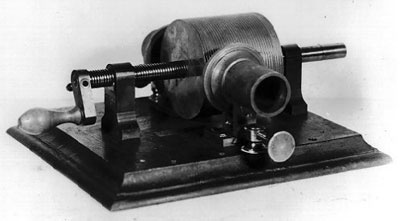Concerning the "Dawn of Recorded Sound"

Thomas Alva Edison, that ever lazy lad who, when he had nothing better to do went out and applied for and was awarded a meager 1,368 separate and distinct patents during his lifetime, one of which was the Cylinder machine pictured above.
Come on now, how many of you have a few cylinder machines hanging around the house? I must have about fifteen or more myself! Anyway, out of all those patents only one was attributed to being a purely "scientific nature" of discovery and that was his "Edison Effect"
What was the "Edison Effect"? No, it wasn't the the reaction- effect of the Patent Office employees when he walked in each time to apply for another patent, it was much more important then that. In fact, Thomas Edison himself had no idea what it was he had observed, so he decided to patent it!!
The "Edison Effect" had to do with thermionic emission, which is the flow of electrons from a metal or metal oxide surface, caused by thermal vibrational energy overcoming the electrostatic forces holding electrons to the surface. The effect increases dramatically with increasing temperature (1000–3000 K), but is always present at temperatures above absolute zero.
Simply stated, while trying to discover the reason for breakage of lamp filaments and uneven blackening (darkest near one terminal of the filament) of the bulbs in his incandescent lamps.
Edison built a bulb with the inside surface covered with metal foil. He connected the foil to the lamp filament through a galvanometer, (...another useful tool we all should keep around the house!) When the foil was given a more negative charge than the filament, no current flowed between the foil and the filament because the cool foil emitted few electrons. However, when the foil was given a more positive charge than the filament, the many electrons emitted from the hot filament were attracted to the foil, causing current to flow. This one-way flow of current was called the Edison effect (although the term is occasionally used to refer to thermionic emission itself). Edison saw no use for this effect, and although he patented it in 1883, he did not study it any further.
Thus, the principle of the Vaccuum Tube was discovered and patented, but Thomas Edison just didn't realize it!! ...What a slacker!
Does this make Edison the "Father of Electronics" too? Maybe the grandfather, but not the "Father of Electronics"
Here's a list of some of his inventions when he had nothing better to do:
1868
- Invented the electrical vote recorder.
1869
- Invented the universal stock ticker and the unison stop.
1872
- Invented the motograph.
- Invented the automatic telegraph system.
- Invented duplex, quadruplex, sextuplex, and multiplex telegraph systems.
- Invented paraffin paper.
- Invented the carbon rheostat.
1875
- Discovered "Etheric Force," an electric phenomenon that is the foundation of wireless telegraphy.
1876
- Invented the electric pen used for the first mimeographs.
1877
- Invented the carbon telephone transmitter, making telephony commercially practical. This included the microphone used in radio.
1877
- Invented the phonograph. This was Edison's favorite invention. He sponsored the Edison Phonograph Polka to help popularize the new device.
1879
- Discovered incandescent light.
- Radically improved dynamos and generators.
- Discovered a system of distribution, regulation, and measurement of electric current-switches, fuses, sockets, and meters.
1880
- Invented the magnetic ore separator.
1880
- Discovered the "Edison Effect," the fundamental principle of electronics.
1885
- Discovered a system of wireless induction telegraph between moving trains and stations. He also patented similar systems for ship-to-shore use.
1891
- Invented the motion picture camera.
1896
- Invented the fluoroscope.
- Invented the fluorescent electric lamp.
1900
- Invented the nickel-iron-alkaline storage battery.
1914
- Invented the electric safety miner's lamp.
- Discovered the process for manufacturing synthetic carbolic acid.
1915
- Conducted special experiments on more than 40 major war problems for the Navy Department. Edison served as Chairman of the Naval Consulting Board and did much other work on National Defense.
I Locating positions of guns by sound ranging.
2 Detecting submarines by sound from moving vessels.
3 Detecting, on moving vessels, the discharge of torpedoes by submarines.
4 The faster turning of ships.
5 Strategic plans for saving cargo boats from harm by enemy submarines.
6 Development of collision mats for submarines and ships.
7 Methods for guiding merchant ships out of mined harbors.
8 Oleum cloud shells.
9 Camouflaging ships.
10 Blocking torpedoes with nets.
11 Increased power for torpedoes.
12 Coastal patrol by submarine buoys.
13 Destroying periscopes with machine guns.
14 Cartridges for taking soundings.
15 Sailing lights for convoys.
16 Smudging skyline.
1 17 Underwater searchlights.
18 High speed signaling with searchlights.
19 Water penetrating projectiles.
20 Airplane detection.
21 Observing periscopes in silhouette.
So now you see the NAVY connection to this whole blog entry!


3 Comments:
Interesting isn't it...He invented the phonograph BEFORE he invented the light bulb!!
Yah sure,if that was true the little on and off light wouldn't work....Duhhh!
He was an amazing man. What is rarely know is that he invented the word "Hello" also.
I find that one of Edison's most interesting and universal inventions...one that we use all over the world to greet each other.
That's clever!
Nice artical ........ Jack
Post a Comment
Subscribe to Post Comments [Atom]
<< Home